Bending Stress in Curved Beam - Study on Seismic Resilience and Behaviour of Ancient and Modern Arches
49 Pages13386 Words246 Views
Added on 2023-05-26
About This Document
This study focuses on the seismic resilience and behaviour of ancient and modern arches, and the torsional buckling of beams. It evaluates the impact of earthquakes on curved beams and the use of shake table models to test the response of structures. The study also discusses the role of expansion joints in curved beams and the failure modes observed. The subject matter is relevant to engineering and architecture students.
Bending Stress in Curved Beam - Study on Seismic Resilience and Behaviour of Ancient and Modern Arches
Added on 2023-05-26
ShareRelated Documents
Running head: BENDING STRESS IN CURVED BEAM
BENDING STRESS IN CURVED BEAM
BENDING STRESS IN CURVED BEAM
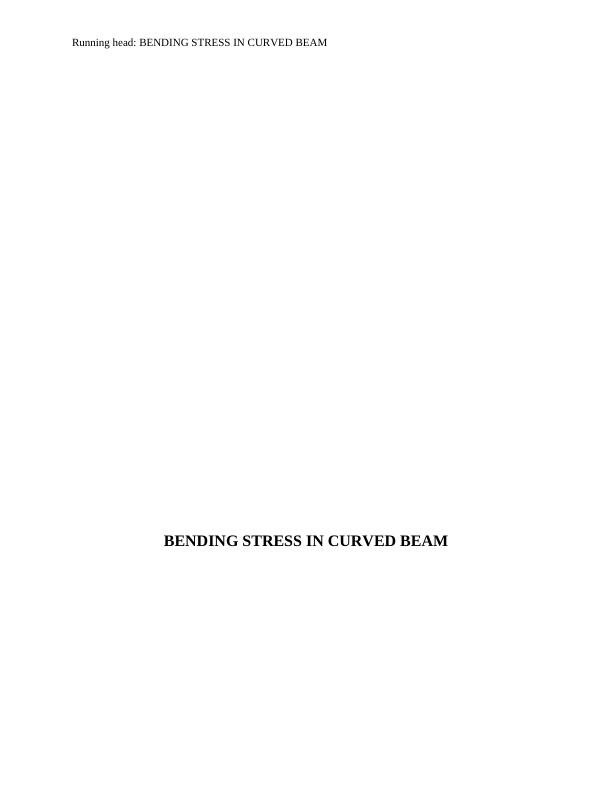
BENDING STRESS IN CURVED BEAM 1
Table of Contents
Introduction......................................................................................................................................2
Task 1: Bending of curved beams...................................................................................................3
1.1 The behaviour of curved beams in past earthquakes.............................................................3
1.2 Shake table model..................................................................................................................6
1.3 Examples of constructions using curved beams..................................................................10
Task 2: Behavior of modern arches vs. the behavior of ancient arches (masonry).......................14
2.1 Failure modes.......................................................................................................................14
2.2 The behaviour of arches in past earthquakes.......................................................................17
2.3 Examples of modern arches and ancient arches...................................................................22
Task 3: Torsional buckling of beams.............................................................................................24
3.1 The reasons behind torsional buckling of beams.................................................................24
3.2 Examples of constructions where the torsional buckling of beams has occurred................25
Conclusion.....................................................................................................................................34
References......................................................................................................................................36
Table of Contents
Introduction......................................................................................................................................2
Task 1: Bending of curved beams...................................................................................................3
1.1 The behaviour of curved beams in past earthquakes.............................................................3
1.2 Shake table model..................................................................................................................6
1.3 Examples of constructions using curved beams..................................................................10
Task 2: Behavior of modern arches vs. the behavior of ancient arches (masonry).......................14
2.1 Failure modes.......................................................................................................................14
2.2 The behaviour of arches in past earthquakes.......................................................................17
2.3 Examples of modern arches and ancient arches...................................................................22
Task 3: Torsional buckling of beams.............................................................................................24
3.1 The reasons behind torsional buckling of beams.................................................................24
3.2 Examples of constructions where the torsional buckling of beams has occurred................25
Conclusion.....................................................................................................................................34
References......................................................................................................................................36
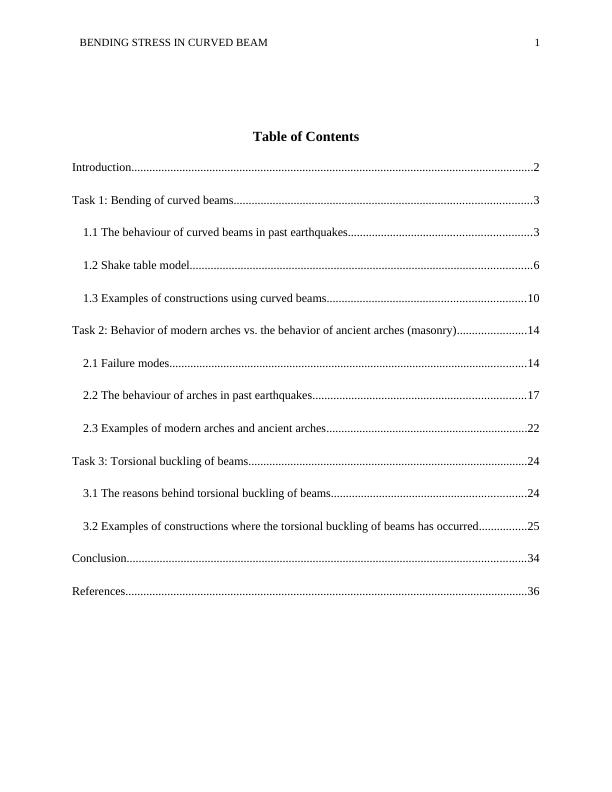
BENDING STRESS IN CURVED BEAM 2
Introduction
A curved beam is generally referred to as a body, the geometric figure of which has been
created by the motion of a plane figure in space. The plane figure is termed as the cross-section
of the curved beam, wherein the center of gravity of the beam consistently follows an axis or a
specific curve. The cross-section of a curved beam can be effectively used to identify the
differences in the curved beams. This study focuses on the curvature of beams concerning
earthquakes. In addition to that, a comparative analysis is mentioned with regards to the varied
behaviour of arches of ancient times with the arches of modern times. For instance, ancient
arches may be illustrated through several medieval architectures, while modern construction
works, such as bridges may be cited as examples of modern arches.
A masonry arch is known to comprise several components, such as a keystone, a
voissour, an impost, an extrados, and an intrados. The other components include a clear span, a
rise, and an abutment. Various types and categories of arches have been explored in this regards
as well. Since beams and may arches are restrained as well as unrestrained, an occurrence
commonly termed as the torsional buckling of beams is found to be prevalent in case the
compression flange becomes free and is found to rotate after being displaced laterally. The
torsional effect has been found to be a result of the combination of both the tensile and the
compressive forces. The reasons for such occurrence have been explored in this study, and the
potential actions for the mitigation of the challenges have been identified in this regards as well.
Introduction
A curved beam is generally referred to as a body, the geometric figure of which has been
created by the motion of a plane figure in space. The plane figure is termed as the cross-section
of the curved beam, wherein the center of gravity of the beam consistently follows an axis or a
specific curve. The cross-section of a curved beam can be effectively used to identify the
differences in the curved beams. This study focuses on the curvature of beams concerning
earthquakes. In addition to that, a comparative analysis is mentioned with regards to the varied
behaviour of arches of ancient times with the arches of modern times. For instance, ancient
arches may be illustrated through several medieval architectures, while modern construction
works, such as bridges may be cited as examples of modern arches.
A masonry arch is known to comprise several components, such as a keystone, a
voissour, an impost, an extrados, and an intrados. The other components include a clear span, a
rise, and an abutment. Various types and categories of arches have been explored in this regards
as well. Since beams and may arches are restrained as well as unrestrained, an occurrence
commonly termed as the torsional buckling of beams is found to be prevalent in case the
compression flange becomes free and is found to rotate after being displaced laterally. The
torsional effect has been found to be a result of the combination of both the tensile and the
compressive forces. The reasons for such occurrence have been explored in this study, and the
potential actions for the mitigation of the challenges have been identified in this regards as well.
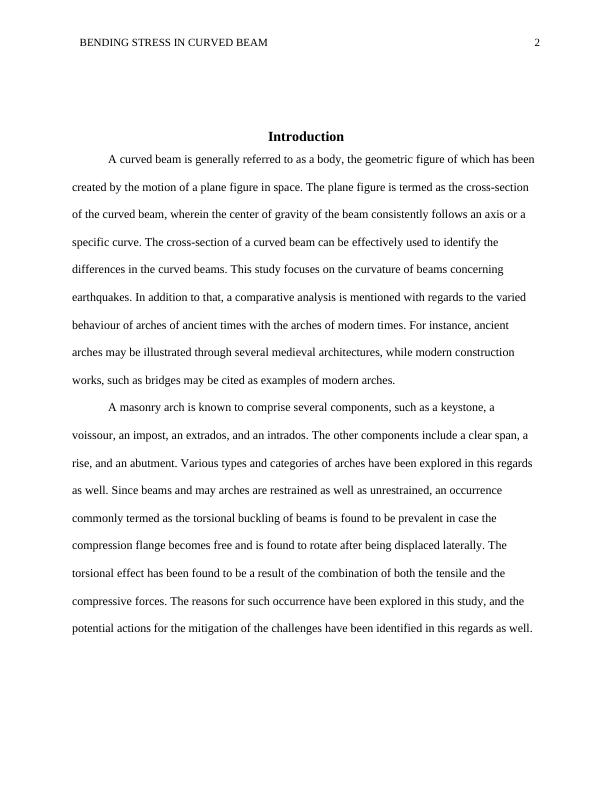
BENDING STRESS IN CURVED BEAM 3
Task 1: Bending of curved beams
1.1 The behaviour of curved beams in past earthquakes
To evaluate the behaviour of curved beams, it is necessary to consider the design of the
curved beam in question. Considering that the area of cross-sectional of a beam is symmetrical, it
is to be estimated that the impact of the load, which is placed at the plane of symmetry. It may be
mentioned in this context that the axis of symmetry is evident on the plane of curvature.
Furthermore, the determination of the stress which is normal to the cross-section of the beam
may be performed with the aid of the formula depicted in Figure 1.
Figure 1: Formula for determination of stress normal to the cross-section of a beam
(Source: Wang, Lee & Huang, 2016)
The formula represented in Figure 1, can be assessed, where ‘N’ is established to be the
longitudinal force, while ‘F’ is the area of cross-section. Furthermore, ‘M’ is the bending
moment established in the cross-section, with regards to the axis, Z0, which passes through ‘C’
which may be defined as the center of gravity of the cross section (Wang, Lee & Huang, 2016).
On the other hand, ‘y’ is determined to be the distance of the fiber to ‘z,' the neutral axis. The
fiber refers to the one, which is being examined concerning ‘z.' ‘Sz= Fy0’ is defined as the static
moment of the area of cross-section, with regards to ‘z.' ‘P' in this respect can be termed as the
radius of curvature of the fiber. In addition to the aforementioned parameters, the displacement
of the neutral axis ‘Y0’ is estimated to be relative to the center of curvature. It is established that
‘Y0’ is directed towards the center of curvature of the beam to be examined.
Task 1: Bending of curved beams
1.1 The behaviour of curved beams in past earthquakes
To evaluate the behaviour of curved beams, it is necessary to consider the design of the
curved beam in question. Considering that the area of cross-sectional of a beam is symmetrical, it
is to be estimated that the impact of the load, which is placed at the plane of symmetry. It may be
mentioned in this context that the axis of symmetry is evident on the plane of curvature.
Furthermore, the determination of the stress which is normal to the cross-section of the beam
may be performed with the aid of the formula depicted in Figure 1.
Figure 1: Formula for determination of stress normal to the cross-section of a beam
(Source: Wang, Lee & Huang, 2016)
The formula represented in Figure 1, can be assessed, where ‘N’ is established to be the
longitudinal force, while ‘F’ is the area of cross-section. Furthermore, ‘M’ is the bending
moment established in the cross-section, with regards to the axis, Z0, which passes through ‘C’
which may be defined as the center of gravity of the cross section (Wang, Lee & Huang, 2016).
On the other hand, ‘y’ is determined to be the distance of the fiber to ‘z,' the neutral axis. The
fiber refers to the one, which is being examined concerning ‘z.' ‘Sz= Fy0’ is defined as the static
moment of the area of cross-section, with regards to ‘z.' ‘P' in this respect can be termed as the
radius of curvature of the fiber. In addition to the aforementioned parameters, the displacement
of the neutral axis ‘Y0’ is estimated to be relative to the center of curvature. It is established that
‘Y0’ is directed towards the center of curvature of the beam to be examined.
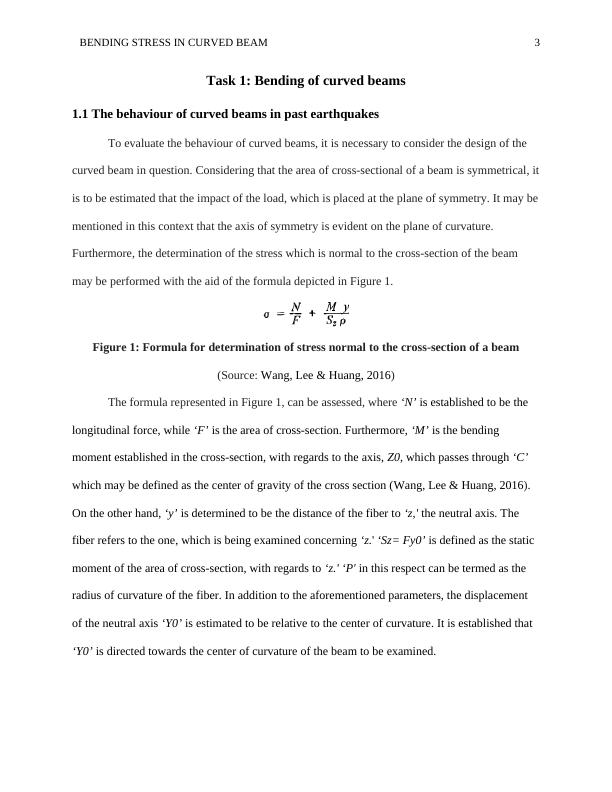
BENDING STRESS IN CURVED BEAM 4
Figure 2: Distribution of stress in a cross-section of a curved beam
(Source: Ni, Chen, Teng & Jiang, 2015)
Figure 2 represents the distribution of stress in a curved beam in case of being bent. It is
to be noted that h and d indicate the height and diameter of the beam's cross-section. It may be
stated in this regards that the concave edges of the beam have the maximum values for the
normal stress. Furthermore, the values of normal stress for the beam may vary in the concave
edges, in accordance with hyperbolic law (Ni, Chen, Teng & Jiang, 2015).
To ascertain or study the behaviour of curved beams concerning earthquakes or seismic
movements, the seismic resilience of the beam may be taken into consideration. Under
experimental conditions, the behaviour of curved beams under seismic activities can be
ascertained by studied certain parameters such as the curvature of the beam, ductile cross frames
and the seismic isolation (Di Re, Addessi & Sacco, 2018). In addition to that, the live load,
column rocking as well as the Abutment-soil interaction are to be taken into account for studying
the behaviour of curved beams under seismic activities.
It may be stated in this regards that severe structural damage has been observed in case of
past earthquakes on horizontally curved bridges. The bridges are to be considered as the curved
beams in this regards. Moreover, one of the major issues noted in this respect has been noted to
Figure 2: Distribution of stress in a cross-section of a curved beam
(Source: Ni, Chen, Teng & Jiang, 2015)
Figure 2 represents the distribution of stress in a curved beam in case of being bent. It is
to be noted that h and d indicate the height and diameter of the beam's cross-section. It may be
stated in this regards that the concave edges of the beam have the maximum values for the
normal stress. Furthermore, the values of normal stress for the beam may vary in the concave
edges, in accordance with hyperbolic law (Ni, Chen, Teng & Jiang, 2015).
To ascertain or study the behaviour of curved beams concerning earthquakes or seismic
movements, the seismic resilience of the beam may be taken into consideration. Under
experimental conditions, the behaviour of curved beams under seismic activities can be
ascertained by studied certain parameters such as the curvature of the beam, ductile cross frames
and the seismic isolation (Di Re, Addessi & Sacco, 2018). In addition to that, the live load,
column rocking as well as the Abutment-soil interaction are to be taken into account for studying
the behaviour of curved beams under seismic activities.
It may be stated in this regards that severe structural damage has been observed in case of
past earthquakes on horizontally curved bridges. The bridges are to be considered as the curved
beams in this regards. Moreover, one of the major issues noted in this respect has been noted to

BENDING STRESS IN CURVED BEAM 5
be the unseating of the deck from the abutment (Di Re, Addessi & Sacco, 2018). This has been
identified as a result of the excessive plane-body motion of the decks, resulting from the seismic
activities. The irregular geometry of the curved beam along with the seismic poundings observed
between the abutments and the decks have been noted to be the prime cause of the failure of the
curved beam structures.
Furthermore, it may be stated in this regards that the maximum seismic response of the curved
beam has been found to be relevant to the angle of input of the designated earthquake (Miyamoto
et al., 2016). The irregularities in the structure of the curved beam or the curved bridge can be
attributed to the interaction between the torsion forces and the moment. The response of the
curved beam structure in response to the input of the one-way earthquake can be determined
through the uniform expression derived from the unfavorable angle of the earthquake. Hence, the
maximum response of the curved beam structure corresponding to the seismic activities of the
earthquake can be determined.
be the unseating of the deck from the abutment (Di Re, Addessi & Sacco, 2018). This has been
identified as a result of the excessive plane-body motion of the decks, resulting from the seismic
activities. The irregular geometry of the curved beam along with the seismic poundings observed
between the abutments and the decks have been noted to be the prime cause of the failure of the
curved beam structures.
Furthermore, it may be stated in this regards that the maximum seismic response of the curved
beam has been found to be relevant to the angle of input of the designated earthquake (Miyamoto
et al., 2016). The irregularities in the structure of the curved beam or the curved bridge can be
attributed to the interaction between the torsion forces and the moment. The response of the
curved beam structure in response to the input of the one-way earthquake can be determined
through the uniform expression derived from the unfavorable angle of the earthquake. Hence, the
maximum response of the curved beam structure corresponding to the seismic activities of the
earthquake can be determined.

BENDING STRESS IN CURVED BEAM 6
Figure 3: Input angles of earthquake acceleration
(Source: Li & Du, 2015)
Figure 3 represents the various input angles of earthquake acceleration. Figure 3(a)
depicts a single-direction input, while Figure 3(b) depicts orthotropic dual-direction inputs. On
the contrary, Figure 3(c) illustrates Skewed dual-direction inputs relating to the seismic activities
of the earthquakes. The input angles are considered concerning a random direction in a plane.
The implementation of the concept of a curved bridge has been widely prevalent in
several architectural structures. The constructions of railways have a widespread implementation
of the curved beams. However, since the 1970s, multiple devastating earthquakes have been
noted by engineers. The impact of the earthquakes on the curved beams or the girder bridge,
which constitutes an important variation of the curved beams, is regarded as vital for the study
(Hsu & Halim, 2017). For instance, the 1971 earthquake of San Fernando is known to have
Figure 3: Input angles of earthquake acceleration
(Source: Li & Du, 2015)
Figure 3 represents the various input angles of earthquake acceleration. Figure 3(a)
depicts a single-direction input, while Figure 3(b) depicts orthotropic dual-direction inputs. On
the contrary, Figure 3(c) illustrates Skewed dual-direction inputs relating to the seismic activities
of the earthquakes. The input angles are considered concerning a random direction in a plane.
The implementation of the concept of a curved bridge has been widely prevalent in
several architectural structures. The constructions of railways have a widespread implementation
of the curved beams. However, since the 1970s, multiple devastating earthquakes have been
noted by engineers. The impact of the earthquakes on the curved beams or the girder bridge,
which constitutes an important variation of the curved beams, is regarded as vital for the study
(Hsu & Halim, 2017). For instance, the 1971 earthquake of San Fernando is known to have
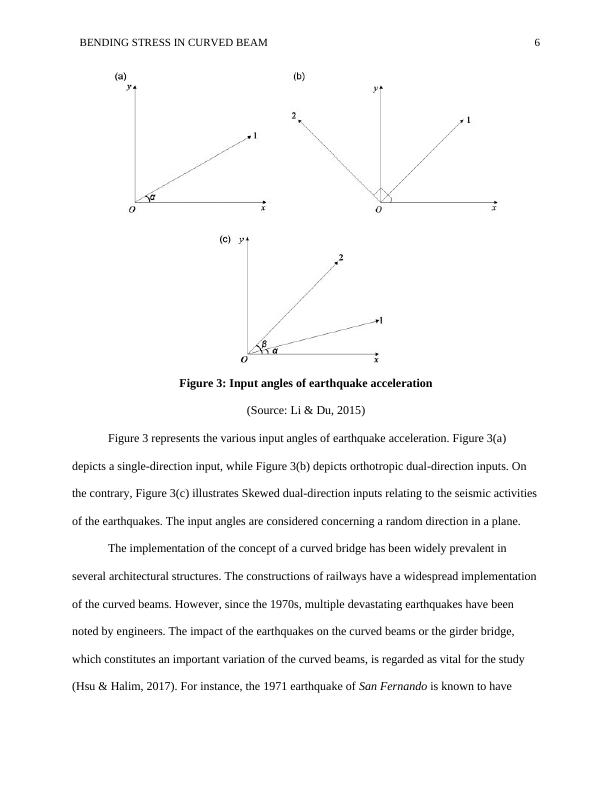
BENDING STRESS IN CURVED BEAM 7
caused extensive damage to a multi-span girder bridge. Hence, special attention has been paid to
the seismic responses generated by curved beams or bridges, as a subject for study and
understanding in the field of engineering (Pydah & Sabale, 2017). The Shake table model has
been noted in this regards to developing a better understanding and knowledge concerning the
matter.
1.2 Shake table model
The shake table model has been an extensive aspect of earthquake engineering. The use
and application of the shake table model are observed as a technique implemented to test the
response of certain structures, such as curved beams, or girder bridges to extensive earthquakes.
Furthermore, the study of the seismic performance of rock slopes and soil is also undertaken
through the shake table model. This model is typically used for the evaluation of the performance
of scales slopes, curved beams, and other structural models with the aid of imitating is simulating
earthquakes recorded over some time (Attary et al., 2015). The specimen or the curved beam or
the curved bridge to be shaken is experimented on until it reaches the point of ‘failure.' With the
aid of modern devices and other innovative technologies, it is possible to interpret the dynamic
behaviour of the curved beams exposed to the artificially simulated earthquakes. The degrees of
freedom are generally considered as 6 in this case of the experiment.
caused extensive damage to a multi-span girder bridge. Hence, special attention has been paid to
the seismic responses generated by curved beams or bridges, as a subject for study and
understanding in the field of engineering (Pydah & Sabale, 2017). The Shake table model has
been noted in this regards to developing a better understanding and knowledge concerning the
matter.
1.2 Shake table model
The shake table model has been an extensive aspect of earthquake engineering. The use
and application of the shake table model are observed as a technique implemented to test the
response of certain structures, such as curved beams, or girder bridges to extensive earthquakes.
Furthermore, the study of the seismic performance of rock slopes and soil is also undertaken
through the shake table model. This model is typically used for the evaluation of the performance
of scales slopes, curved beams, and other structural models with the aid of imitating is simulating
earthquakes recorded over some time (Attary et al., 2015). The specimen or the curved beam or
the curved bridge to be shaken is experimented on until it reaches the point of ‘failure.' With the
aid of modern devices and other innovative technologies, it is possible to interpret the dynamic
behaviour of the curved beams exposed to the artificially simulated earthquakes. The degrees of
freedom are generally considered as 6 in this case of the experiment.

End of preview
Want to access all the pages? Upload your documents or become a member.
Related Documents
Behavior and Failure Mechanism of Modern and Ancient Archeslg...
|11
|2810
|338
Torsional Buckling of Beams Reportlg...
|16
|3450
|209
Static Engineering System Assignmentlg...
|32
|3416
|392
